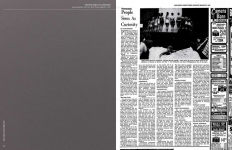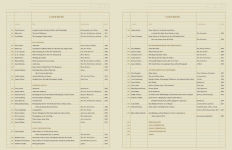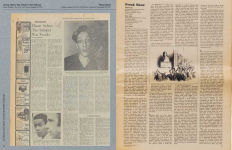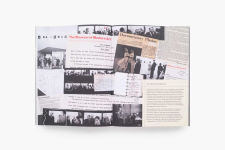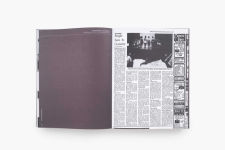Diane Arbus Documents
A groundbreaking publication offering insight into the critical conversations and misconceptions around this unrivaled artist’s works.
Best known for her penetrating images exploring what it means to be human, Diane Arbus is a pivotal and singular figure in American postwar photography. Arbus’s black-and-white photographs demolish aesthetic conventions and upend all certainties. Both lauded and criticized for her photographs of people deemed “outsiders,” Arbus continues to be a lightning rod for a wide range of opinions surrounding her subject matter and approach. Critics and writers have described her work as “sinister” and “appalling” as well as “revelatory,” “sincere,” and “compassionate.” Through an assemblage of articles, criticism, and essays from 1967 to the present, Diane Arbus Documents charts the reception of the revolutionary photographer's work.
Illuminating fifty years of evolution in the field of art criticism, Documents provides a new template for understanding the work of any formidable artist. Organized in eleven sections that focus on major exhibitions and significant events emerging from Arbus’s work, as well as on her methods and intentions, the sixty-nine facsimiles of previously published articles and essays––an archive by all accounts––trace the discourse on Arbus, contextualizing her inimitable oeuvre. Supplemented by an annotated bibliography of more than six hundred entries and a comprehensive exhibition history, Documents serves as an important resource for photographers, researchers, art historians, and art critics, in addition to students of art criticism and the interested reader alike.
1140975536
Best known for her penetrating images exploring what it means to be human, Diane Arbus is a pivotal and singular figure in American postwar photography. Arbus’s black-and-white photographs demolish aesthetic conventions and upend all certainties. Both lauded and criticized for her photographs of people deemed “outsiders,” Arbus continues to be a lightning rod for a wide range of opinions surrounding her subject matter and approach. Critics and writers have described her work as “sinister” and “appalling” as well as “revelatory,” “sincere,” and “compassionate.” Through an assemblage of articles, criticism, and essays from 1967 to the present, Diane Arbus Documents charts the reception of the revolutionary photographer's work.
Illuminating fifty years of evolution in the field of art criticism, Documents provides a new template for understanding the work of any formidable artist. Organized in eleven sections that focus on major exhibitions and significant events emerging from Arbus’s work, as well as on her methods and intentions, the sixty-nine facsimiles of previously published articles and essays––an archive by all accounts––trace the discourse on Arbus, contextualizing her inimitable oeuvre. Supplemented by an annotated bibliography of more than six hundred entries and a comprehensive exhibition history, Documents serves as an important resource for photographers, researchers, art historians, and art critics, in addition to students of art criticism and the interested reader alike.
Diane Arbus Documents
A groundbreaking publication offering insight into the critical conversations and misconceptions around this unrivaled artist’s works.
Best known for her penetrating images exploring what it means to be human, Diane Arbus is a pivotal and singular figure in American postwar photography. Arbus’s black-and-white photographs demolish aesthetic conventions and upend all certainties. Both lauded and criticized for her photographs of people deemed “outsiders,” Arbus continues to be a lightning rod for a wide range of opinions surrounding her subject matter and approach. Critics and writers have described her work as “sinister” and “appalling” as well as “revelatory,” “sincere,” and “compassionate.” Through an assemblage of articles, criticism, and essays from 1967 to the present, Diane Arbus Documents charts the reception of the revolutionary photographer's work.
Illuminating fifty years of evolution in the field of art criticism, Documents provides a new template for understanding the work of any formidable artist. Organized in eleven sections that focus on major exhibitions and significant events emerging from Arbus’s work, as well as on her methods and intentions, the sixty-nine facsimiles of previously published articles and essays––an archive by all accounts––trace the discourse on Arbus, contextualizing her inimitable oeuvre. Supplemented by an annotated bibliography of more than six hundred entries and a comprehensive exhibition history, Documents serves as an important resource for photographers, researchers, art historians, and art critics, in addition to students of art criticism and the interested reader alike.
Best known for her penetrating images exploring what it means to be human, Diane Arbus is a pivotal and singular figure in American postwar photography. Arbus’s black-and-white photographs demolish aesthetic conventions and upend all certainties. Both lauded and criticized for her photographs of people deemed “outsiders,” Arbus continues to be a lightning rod for a wide range of opinions surrounding her subject matter and approach. Critics and writers have described her work as “sinister” and “appalling” as well as “revelatory,” “sincere,” and “compassionate.” Through an assemblage of articles, criticism, and essays from 1967 to the present, Diane Arbus Documents charts the reception of the revolutionary photographer's work.
Illuminating fifty years of evolution in the field of art criticism, Documents provides a new template for understanding the work of any formidable artist. Organized in eleven sections that focus on major exhibitions and significant events emerging from Arbus’s work, as well as on her methods and intentions, the sixty-nine facsimiles of previously published articles and essays––an archive by all accounts––trace the discourse on Arbus, contextualizing her inimitable oeuvre. Supplemented by an annotated bibliography of more than six hundred entries and a comprehensive exhibition history, Documents serves as an important resource for photographers, researchers, art historians, and art critics, in addition to students of art criticism and the interested reader alike.
95.0
In Stock
5
1

Diane Arbus Documents
496
Diane Arbus Documents
496Hardcover
$95.00
95.0
In Stock

Product Details
| ISBN-13: | 9781644230657 |
|---|---|
| Publisher: | David Zwirner Books |
| Publication date: | 09/27/2022 |
| Pages: | 496 |
| Sales rank: | 621,473 |
| Product dimensions: | 8.60(w) x 11.10(h) x 1.80(d) |
About the Author
From the B&N Reads Blog

